
I was elbow-deep in creating the Fictionary Story Arc structure, the skeleton key to the Fictionary story-editing software. Then I had a forehead-slapping, coffee-spilling revelation. It was like a bolt of lightning had shot straight through my trusty writer’s cap. The very cornerstone of every story arc element, I realised, was its intrinsic ability to build up to a compelling climax.
Talk about an “aha” moment!
The climax, my friends, is the cherry atop the story sundae, the punchline to a well-crafted joke, the crescendo in a symphony of words. It’s the point where your reader’s heart should pound in anticipation, their eyes glued to the page.
Getting there, though, is a meticulously planned journey, much like making a risotto. Slowly adding the ingredients, giving it a good stir, allowing the flavours to meld together before adding the next component. Patience, pacing, and a pinch of creative zest. That’s your ticket to a riveting climax.
It’s also the driving principle behind our Fictionary software. Kristina Stanley designed Fictionary to help you weave those intricate story threads together. It allows you to weave a narrative tapestry that builds to an unforgettable peak.
So let’s flex our creative muscles and dive into the art of building a tantalising climax.
With Fictionary as our trusty guide, we’re on the road to creating stories that leave our readers breathless and hungry for more.
Take a free trial of Fictionary today and take your story to the next level.
Understanding the Climax

Imagine you’re on a roller coaster (or, if you’re not an adrenaline junkie like me, imagine you’re observing a roller coaster from a safe distance).
You see the coaster climb steadily up, up, up, until it reaches the apex.
That moment at the top, right before the stomach-churning plummet, where time seems to pause, is the compelling climax in a narrative. It’s the peak of tension, the decisive confrontation, the moment where everything in your story has led and everything that follows is fallout.
Now, let’s switch metaphors, shall we?
Picture your story as a journey up a mountain using the Fictionary Story Arc.
After a tranquil saunter through the valley that sets up your story, you reach the steep incline of the mountain. The inciting incident. This incident propels your protagonist (and readers) onto the mountain’s slope. Plot Points 1 and 2, along with the Middle Plotpoint, represent the steep, challenging climb.
Finally, your protagonist reaches the summit—the climax—where they confront their biggest challenge yet. It’s the turning point where they must draw on all they’ve learned and change to achieve their goal.
A compelling climax isn’t just about the most dramatic confrontation or revelation. It’s about more than shocking your readers or making their palms sweat. While those are pleasant side effects, the climax is really about transformation. It’s when your character’s inner journey (their character arc) intersects with their outer journey (the plot).
According to the Fictionary Story Arc, the climax sequence occurs between 85 and 95% of the way through your story. It’s the most intense point of conflict in your story. It’s where your protagonist either achieves their goal (in a positive arc) or tragically fails (in a negative arc).
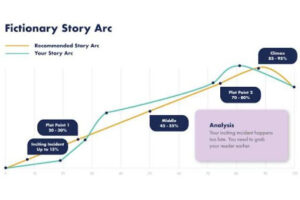
Here’s where the magic happens.
The climax harmoniously combines your story’s external events and your character’s internal journey.
It’s where you fully express the theme of your story and where your protagonist’s transformation is complete. It’s where your character, whether they succeed or fail, finally understands the true stakes. Understanding this interplay is vital for writing an engrossing climax.
But fear not, we’ll dive into the how-to’s shortly.
Remember, my writerly chums, the climax is more than a plot point. The climax is the point of the plot. It’s what readers have been reading for. So let’s keep ascending this narrative mountain, shall we?
Take a free trial of Fictionary today and take your story to the next level.
The Climax as a Turning Point
Picture yourself once again on our metaphorical mountain.
We’ve climbed and climbed, and now we’re at the top. What happens now? It’s certainly not the time for a picnic, although the view is probably quite nice. No, at the climax, it’s time for a turn. A significant one.
The climax is, without a doubt, the most impactful turning point in your narrative. It’s where your story pivots from build-up to resolution, from climbing to descending.
Now, I’m not suggesting that your protagonist literally needs to do a pirouette (unless your story is ballet-themed). No, no. The turning point refers to a seismic shift in the protagonist’s journey.
A compelling climax is a turning point where you seal your protagonist’s fate.
Whether they succeed or fail in their goals, it’s here the outcome becomes inevitable. It’s the point of no return, amplified. This turning point, both in terms of the plot and character arc, is what gives the climax its power. It’s the moment of highest tension, but it also marks the greatest potential for transformation.
So remember, as you’re crafting your climax, think about the turn.
The Climax and Conflict Resolution

We’re still atop the mountain. We’ve taken the turn. Now, what’s left?
Ah, yes.
The conflict that’s been nagging at your protagonist like an unattended-to notification bell. The climax is where you need to address it.
The climax serves as the stage for the confrontation between your protagonist and the central conflict. It’s where the protagonist employs all the skills, knowledge, and growth they’ve gained throughout the story to face this conflict.
Now, this doesn’t mean you need to tie every single issue up in a neat bow at the climax. But it means that the core conflict—the one driving the narrative—needs to reach its peak confrontation.
The resolution of the conflict may be a triumphant success, a heartbreaking failure, or something in between.
Regardless of the outcome, it’s through this confrontation that your protagonist (and your readers) gain a profound understanding of the story’s central themes and the protagonist’s transformation.
The climax, in its conclusion of the major conflict, completes the story arc and paves the way for the resolution. So ensure that your climax doesn’t merely skim over the conflict. It must dive headfirst into it. After all, a climax without conflict resolution is like a mystery novel without a revelation.
Deeply unsatisfying and incomplete.
Essential Ingredients for a Compelling Climax
High Stakes

One does not simply saunter into the climax of a story, chomping on popcorn.
Oh, no.
This is the point where the stakes must be as high as a trapeze wire. We’re talking about what’s most precious to the characters hanging in the balance. The most important thing to your protagonist could be:
- Their lives
- Their loved ones
- The last slice of pizza in the box
Whatever.
High stakes lend a sense of urgency and desperation to the climax. Both these things keep readers nibbling nervously on their fingernails and deeply invested in the outcome. Think about Frodo struggling against Gollum in the fires of Mount Doom.
Now that’s what I call high stakes! No, literally, it’s atop a mountain.
Emotional Engagement
I like to think of emotional engagement as the key piece that makes the climax sing.
This is where all the emotional threads of your narrative should converge. Your reader needs to feel what your protagonist feels. If it’s an earth-shattering moment for your character, it should be for your reader too.
Take Harry Potter’s ultimate battle with Voldemort in Harry Potter and the Deathly Hallows. This compelling climax doesn’t just involve spell-casting. It’s the highest point of emotion in the entire series. And, it’s the culmination of Harry’s emotional journey from a boy who lived to a wizard ready to sacrifice his life for the wizarding world.
Unpredictability
Finally, let’s sprinkle in some unpredictability.
A compelling climax should take the reader by surprise but in a way that doesn’t seem out of left field. It’s a delicate balance. You don’t want a plot twist so twisty it turns into a pretzel of confusion, but it should be twisty enough to make your readers exclaim, “Wow, I did not see that coming!”
But remember, the climax, while surprising, must still be logical and satisfying within the context of your story.
Common Climax Pitfalls to Avoid
Rushed Resolution
Listen up, word warriors. Patience is not only a virtue but an essential ingredient in the climax of your narrative.
It’s like baking a soufflé. If you rush it, you end up with a flat, disappointing mess.
A rushed resolution leaves your readers feeling cheated, as if they’ve raced through all those pages for a finish that’s over quicker than a hiccup. So, take your time, let the climax unfold at its own pace, give your characters and readers the resolution they deserve. Don’t run for the finish line… strut towards it.
Lack of Sufficient Build-up
Have you ever tried lifting a heavy weight without warming up first?
Yeah, it rarely ends well.
The same goes for your story’s climax. Skipping the build-up is like inviting someone to jump on a roller coaster ride mid-loop.
It’s jarring, disorienting, and not as enjoyable as it should be. The climax is the grand payoff of all the tension, conflict, and stakes you’ve been carefully weaving into your story. Skimp on this, and your climax will feel totally unsatisfying.
Too Predictable
Sure, there’s comfort in predictability. I mean, who doesn’t love a good old, reliable pair of slippers?
But in your story’s climax, predictability is the equivalent of a spoiler.
If your reader can see the climax coming from a mile away, it diminishes the impact.
Remember, you want to surprise your readers, not give them a sense of déjà vu. Twisting expectations can turn a good climax into an unforgettable one. But keep it organic. A climax that reads like a haphazard plot twist will leave your readers feeling like you’ve hit them with a random flying object.
Confused and a little peeved.
Take a free trial of Fictionary today and take your story to the next level.
Practical Tips for Writing a Powerful Climax

Your story’s climax, like a perfect cup of coffee, needs just the right amount of brew time. You should serve it at the right temperature and add a dash of unpredictability.
So a perfect climax comes down to one thing…
Balance.
It’s a symphony of timing, anticipation, and emotional investment. I’d love to share some practical tips that will help you serve your readers with a climax they won’t soon forget.
Set the Stage
Setting matters, and your climax is no exception. Consider how the environment can enhance or amplify the action, tension, and emotional stakes of your climax. Remember, a setting isn’t just a place, but a presence.
Plan Your Pacing
The right pacing is crucial for a climax. This doesn’t mean everything needs to speed up. Quite the contrary. Sometimes slowing down at the right moment can add tension and make the climax even more gripping. Again, a great climax is like a rollercoaster ride. The build-up, the anticipation, and the plummet are equally important.
Don’t Neglect Character Development
The climax is a pivotal moment for your characters. It’s where they’ll confront their fears, make hard choices, and show growth. Remember, your climax isn’t just an event. It’s a crucible for character transformation.
Surprise But Don’t Confuse
Twists and surprises can make a climax unforgettable, but they should still align with the story’s logic and character development. A ‘deus ex machina’ (where something or someone else solves the central conflict for your protagonist) can feel unsatisfying. Endings like these cheat your reader out of a well-earned resolution.
Revise, Revise, Revise
Writing an interesting climax often comes down to refining and reshaping. Don’t be afraid to revise until it feels right. After all, the devil—and the delight—is in the details.
The Fictionary software is a powerhouse tool for revising your climax.
Fictionary enables you to pinpoint exactly where your climax falls. Then you can assess whether it’s positioned for maximum impact. It also helps you scrutinise the tension and stakes surrounding the climax, ensuring they escalate effectively.
Fictionary can also aid in identifying areas lacking emotional payoff or unpredictability. Both these things are vital elements of a gripping climax.
With this dynamic tool, you gain a holistic view of your story structure. This empowers you to craft a climax that not only satisfies your reader’s expectations, but leaves them enthralled.
Writing an engrossing climax requires:
Thoughtful planning
A deep understanding of your characters
A hearty dose of creativity
With these practical tips, you’re well on your way to creating a climax that will leave your readers spellbound and craving more.
Now, before you go forth and brew the perfect climax, let’s look at three examples of great climaxes in fiction.
Take a free trial of Fictionary today and take your story to the next level.
–
3 Superbly Written Climaxes (Spoiler Alerts for The Elfstones of Shannara, The Girl Before, and Bridget Jones’s Diary)
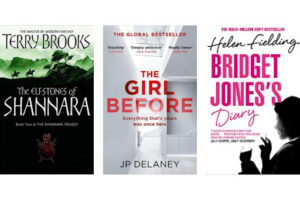
The Elfstones of Shannara by Terry Brooks
In The Elfstones of Shannara, the climax is a pulse-pounding fusion of high stakes and emotional payoff.
The fate of the Four Lands hangs in the balance as the young elfin princess, Amberle, must renew the Forbidding, a magical barrier holding monstrous demons at bay. To do this, she must sacrifice her humanity, turning herself into the next incarnation of a magical tree called the Ellcrys.
This climax is poignant because it embodies the themes of sacrifice, bravery, and duty that are woven throughout the narrative. It leaves the readers both satisfied and emotionally moved, making it a superbly executed climax.
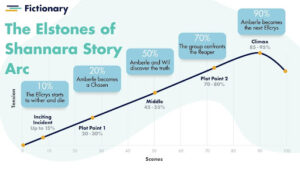
The Girl Before by J.P. Delaney
The Girl Before is a psychological thriller whose climax hinges on the unveiling of disturbing truths.
Jane’s climactic confrontation with Simon is the boiling point of the narrative, and a true testament to an expertly crafted climax.
The stakes couldn’t be higher, as Jane unravels Simon’s twisted identity. He nearly burns Jane alive in a terrifying showdown. The intense danger Jane faces grips readers in a vice-like tension, leaving us breathless and on edge.
But it’s more than a physical battle.
It’s a psychological one too, as Jane fights against the deceit that’s shrouded her relationship with Simon.
This climax is powerful because it’s a culmination of the story’s physical conflict. It’s also a pivotal moment of emotional revelation and transformation for Jane. It’s a defining instance that pushes Jane to her limits, and ultimately, to her awakening, making it a memorable, impactful climax.
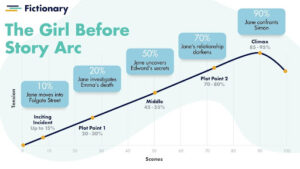
Bridget Jones’s Diary by Helen Fielding
The climax of Bridget Jones’s Diary presents a delightful combination of comedy and romance.
Bridget, our loveable protagonist, finally shares a passionate kiss with Mark, the dashing and aloof hero.
The scene is the culminating point of their simmering tension and unspoken affection. It’s a payoff that satisfies the readers who’ve been cheering for their romance from the beginning. But it’s more than just a passionate kiss—it’s the moment Bridget realises she’s loved, just as she is, without having to transform into someone she’s not.
It’s a beautifully crafted climax because it resolves the romantic conflict and provides a deep, emotional payoff.
The climax resolves the ‘will they, won’t they?’ conflict. It also reaffirms Bridget’s journey of self-love and acceptance, making it a powerfully effective climax.
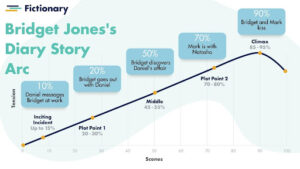
Conclusion: How to Write a Compelling Climax for a Story
In the realm of storytelling, the climax is the crown jewel. It’s the defining moment where all the pieces of your plot come together in a crescendo of tension, emotion, and resolution.
Crafting an interesting climax isn’t as intimidating as wrestling a dragon in a pit of lava. Rather, it’s a careful weaving together of elements we’ve discussed.
Remember to use this checklist when crafting your climax:
- Make your climax is the last (and most pivotal) turning point in the narrative
- Ensure the climax resolves of the central conflict
- Keep your stakes sky-high
- Make your emotional engagement deeper than the Grand Canyon
- Add a twist of unpredictability to keep your readers on their toes
- Use The Fictionary Story Arc as your trusty guide
Avoid the pitfalls of a rushed resolution, insufficient build-up, and a climax more predictable than a Monday morning. Keep these tips in mind, and you’re well on your way to crafting a climax that’s memorable and engaging.
And hey, inspiration is just a book away.
The Elfstones of Shannara, The Girl Before, and Bridget Jones’s Diary are just a few examples of superb climaxes. They capture hearts, blow minds, and linger long after the last page.
So, whip out that pen, brave author, and craft your unforgettable climax.
After all, a story without a climax is like a joke without a punchline, and we’re all here for a good laugh, aren’t we?
Next step: Take a free trial of Fictionary
Fictionary is the only software out there that’s dedicated to story structure and structural editing. If you want to make sure that your climax packs a real punch, Fictionary will help you get there.

Take a free trial of Fictionary today and take your story to the next level.

